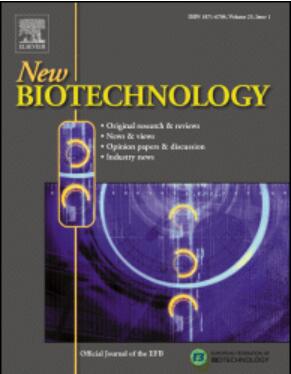Exploring simultaneous production of poly(3-hydroxybutyrate) and exopolysaccharides in cyanobacteria-rich microbiomes
IF 4.5
2区 生物学
Q1 BIOCHEMICAL RESEARCH METHODS
引用次数: 0
Abstract
The aim of this study was to explore the viability of the dual production of poly(3-hydroxybutyrate) (PHB) and exopolysaccharides (EPS) by seven microbiomes rich in cyanobacteria. Our initial experiments involved to screen for EPS-producing candidates and examine the impact of salinity and acetate on EPS synthesis. Salinity's known influence on EPS production and acetate's role in enhancing PHB production guided our parameter selection. Surprisingly, neither the introduction of an external carbon source (acetate) nor exposure to an abiotic stressor (salt) significantly altered EPS synthesis rates, which ranged from 25 to 150 mg·L−1, or its composition, with glucose being the dominant sugar component. Scaling up to a 3 L photobioreactor, we achieved simultaneous biopolymer production, reaching up to 205 mg·L−1 EPS and 87 mg·L−1 PHB. Additionally, the presence of uronic acid in the EPS facilitated biomass flocculation, streamlining the separation process, and potentially reducing associated time and costs.
求助全文
约1分钟内获得全文
求助全文
来源期刊

New biotechnology
生物-生化研究方法
CiteScore
11.40
自引率
1.90%
发文量
77
审稿时长
1 months
期刊介绍:
New Biotechnology is the official journal of the European Federation of Biotechnology (EFB) and is published bimonthly. It covers both the science of biotechnology and its surrounding political, business and financial milieu. The journal publishes peer-reviewed basic research papers, authoritative reviews, feature articles and opinions in all areas of biotechnology. It reflects the full diversity of current biotechnology science, particularly those advances in research and practice that open opportunities for exploitation of knowledge, commercially or otherwise, together with news, discussion and comment on broader issues of general interest and concern. The outlook is fully international.
The scope of the journal includes the research, industrial and commercial aspects of biotechnology, in areas such as: Healthcare and Pharmaceuticals; Food and Agriculture; Biofuels; Genetic Engineering and Molecular Biology; Genomics and Synthetic Biology; Nanotechnology; Environment and Biodiversity; Biocatalysis; Bioremediation; Process engineering.
 求助内容:
求助内容: 应助结果提醒方式:
应助结果提醒方式:


